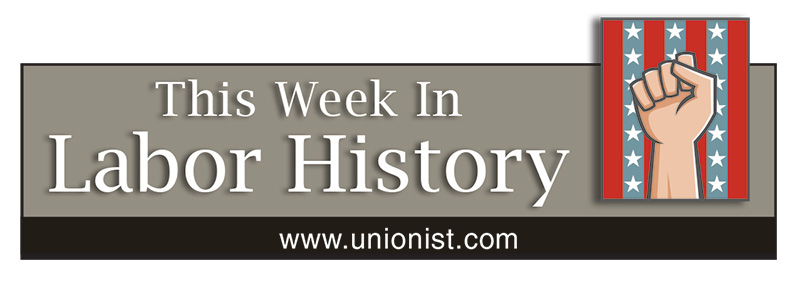This week in labor history: November 30-December 6

DECEMBER 1
1913 – The Ford Motor Co. introduces the continuous moving assembly line which can produce a complete car every two-and-a-half hours.
1930 – Kellogg cereal adopts six-hour day.
1955 – African-American Rosa Parks refuses to go to the back of a Montgomery, Ala., bus, fueling the growing civil rights movement’s campaign to win desegregation and end the deep South’s “Jim Crow” laws.
DECEMBER 2
1911 – A Chicago “slugger,” paid $50 by Labor unions for every scab he “discouraged,” described his job in an interview: “Oh, there ain’t nothing to it. I gets my 50, then I goes out and finds the guy they wanna have slugged, then I gives it to ’im.”
2009 – Walmart Stores Inc. agrees to pay $40 million to 87,500 Massachusetts employees who claimed the retailer denied them rest and meal breaks, manipulated timecards and refused to pay overtime.
DECEMBER 3
1866 – Textile strikers win 10-hour day, Fall River, Mass.
1867 – The San Francisco Board of Supervisors passes an ordinance setting an eight-hour workday for all city employees.
1910 – IWW union Brotherhood of Timber Workers organized.
1919 – Canada’s Quebec Bridge, spanning the St. Lawrence River, opens to traffic on this day after the deaths of 89 construction workers in the course of the job. A flawed design was blamed for a 1907 collapse that killed 75; another 13 died in 1916 when a hoisting device failed as the central span was being lifted.
1946 – General strike begins in Oakland, Calif., started by female department store clerks.
1976 – Some 5,000 union construction workers in Oahu, Hawaii, march to City Hall in protest of a proposed construction moratorium by the city council.
2001 – Arrests began today in Middleton, N.J., of teachers striking in violation of a no-strike law. Ultimately 228 educators were jailed for up to seven days before they were released following the Middleton Township Education Association’s agreement to take the dispute to mediation.
DECEMBER 4
1943 – President Roosevelt announces the end of the Works Progress Administration (WPA), concluding the four-year run of one of the American government’s most ambitious public works programs. It helped create jobs for roughly 8.5 million people during the Great Depression and left a legacy of highways and public buildings, among other public gains.
1952 – UAW President Walter Reuther elected president of the Congress of Industrial Organizations.
DECEMBER 5
1911 – Unionists John T. and James B. McNamara are sentenced to 15 years and life, respectively, after confessing to dynamiting the Los Angeles Times building during a drive to unionize the metal trades in the city. They placed the bomb in an alley next to the building, set to detonate when they thought the building would be empty; it went off early, and an unanticipated gas explosion and fire did the real damage, killing 20 people. The newspaper was strongly conservative and anti-union.
1955 – Ending a 20-year split, the two largest labor federations in the U.S. merge to form the AFL-CIO, with a membership estimated at 15 million.
1999 – AFL-CIO President John Sweeney welcomes the collapse of World Trade Organization talks in Seattle, declaring, “No deal is better than a bad deal.”
2008 – The U.S. Department of Labor reports employers slashed 533,000 jobs the month before — the most in 34 years — as the Great Recession surged. The unemployment rolls had risen for seven months before that and were to continue to soar for another 10 months before topping 10 percent and beginning to level off late the following year.
DECEMBER 6
1869 – African-American delegates met in Washington, D.C., to form the Colored National Labor Union. Isaac Myers was the CNLU’s founding president; Frederick Douglas became president in 1872.
1884 – The Washington Monument is completed in Washington, D.C. On the interior of the monument are 193 commemorative stones, donated by numerous governments and organizations from all over the world; one of them is from the Int’l Typographical Union, founded in 1852. In 1986 the ITU merged into the Communications Workers of America.
1907 – A total of 361 coal miners die at Monongah, W.Va., in nation’s worst mining disaster.
1977 – United Mine Workers begin what is to become a 110-day national coal strike.
(Compiled by David Prosten, founder of Union Communication Services)


Leave a Reply